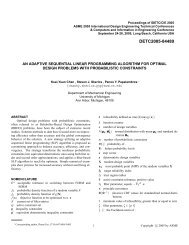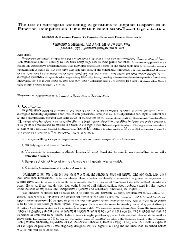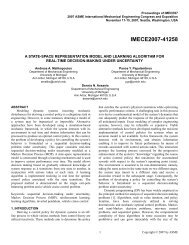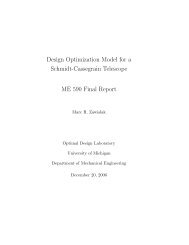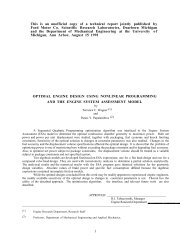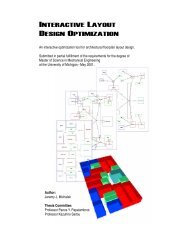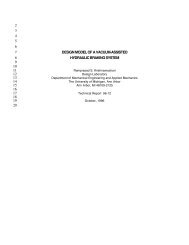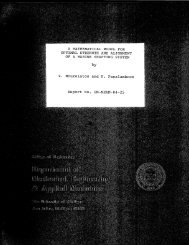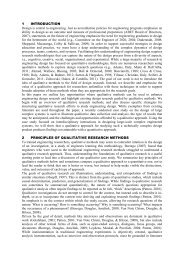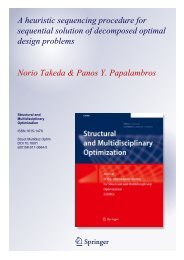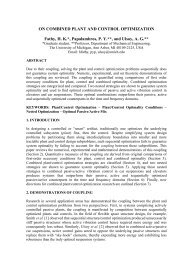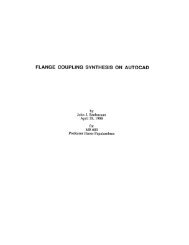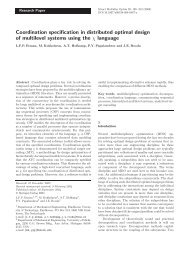Decomposition Analysis of an Automotive Powertrain Design ...
Decomposition Analysis of an Automotive Powertrain Design ...
Decomposition Analysis of an Automotive Powertrain Design ...
You also want an ePaper? Increase the reach of your titles
YUMPU automatically turns print PDFs into web optimized ePapers that Google loves.
Regarding valve timing, a number <strong>of</strong> design limitations exist for the valvetrain to function<br />
successfully. First the events are bounded so they occur in the appropriate region <strong>of</strong> the<br />
thermodynamic cycle. Second, the difference,<br />
g 25 : (i vo - e vc ) / 50 - 1.0 ≤ 0 (88)<br />
is bounded to preclude excessive residual fraction at idle conditions. Third, limits exist on the<br />
valvetrain acceleration. For both intake <strong>an</strong>d exhaust cams, the acceleration is defined as the second<br />
derivative <strong>of</strong> the lift pr<strong>of</strong>ile as a function <strong>of</strong> cam <strong>an</strong>gle <strong>an</strong>d expressed in units <strong>of</strong> cm/deg 2 .<br />
For<br />
decomposition <strong>an</strong>alysis purposes they are expressed as<br />
g 26 : -.008 ≤ acc iv (i vo , i vc, i lift ) ≤ 0.011 (89)<br />
g 27 : -.008 ≤ acc ev (e vo, e vc, e lift ) ≤ 0.011 (90)<br />
The specific bounds depend on the valvetrain type, -0.008 <strong>an</strong>d 0.011 correspond to the pushrod<br />
valvetrain used in the example.<br />
Appendix A summarizes the complete model as presented. Defining equations are treated as<br />
zero-valued equalities <strong>an</strong>d each function is given a unique name <strong>an</strong>d number. These identifiers are<br />
used in <strong>an</strong>notating the FDT <strong>an</strong>d corresponding adjacency matrices <strong>of</strong> the optimization model. The<br />
optimal design problem statement is then as follows.<br />
maximize MPG m-h Metro-highway fuel economy<br />
subject to<br />
g 1 : NOx/0.4 -1 ≤ 0 CAA driven constraint on NOx<br />
g 2 : τ 0-60 /τ ο -1 ≤ 0 0-60 mph time; τ ο = 11.0 sec<br />
g 3 : τ 5-20 /τ 1 -1 ≤ 0 5-20 mph time; τ 1 = 1.81 sec.<br />
g 4 : S base /S 0-4 - 1 ≤ 0 Launch dist<strong>an</strong>ce; S base =88.4 ft.<br />
g 5 : 30.0 /α s - 1 ≤ 0 Starting gradability ( > th<strong>an</strong> 30%)<br />
g 6 : 65 / V c - 1 ≤ 0 Cruising velocity ( > 65 mph @ 6% grade)<br />
g 7 : T e (N e )/T emax (N e ) -1 ≤ 0 Lugging limits<br />
g 8 : c r - 13.2 + 0.045 b ≤ 0 Knock limited bore<br />
g 9 : θ 0−90 / 70 -1 ≤ 0 Combustion stability constraint<br />
g 10 : 2. - ξ fd ≤ 0 Final drive ratio constraint<br />
g 11 : ξ fd - 5 ≤ 0 Final drive ratio constraint<br />
g 12 : 1.6 - ξ 1 / ξ 2 ≤ 0 Step down ratio constraint



